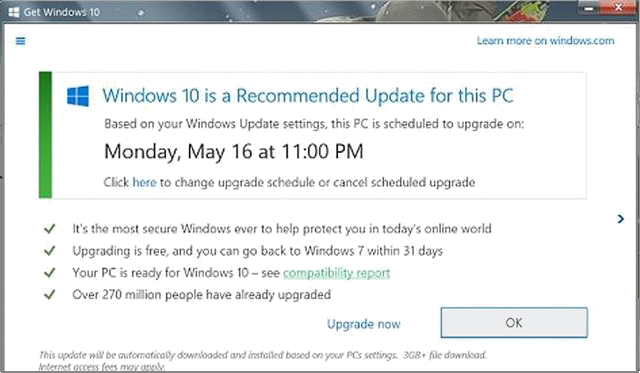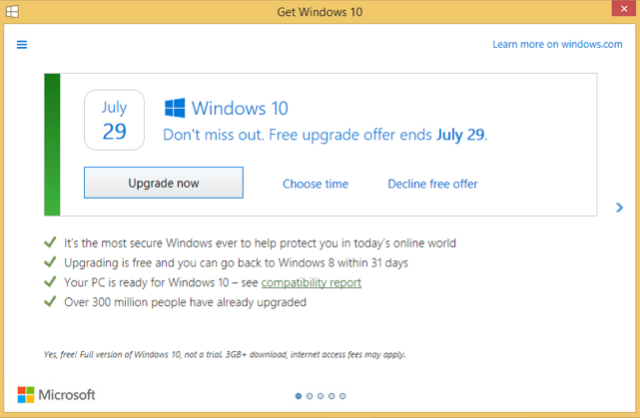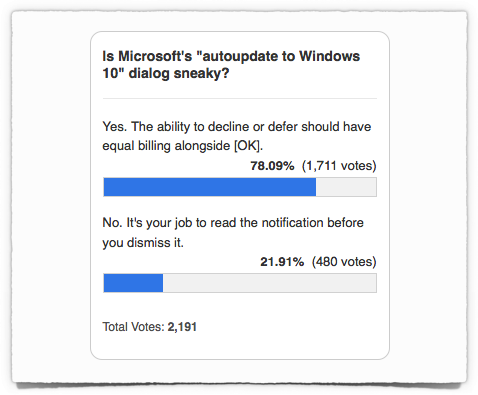Windows 10 now asks nicely if you want your free upgrade
Just over a month ago, we wrote about a update dialog for Windows 10 that caused a bit of a stir.
Many people have their Windows computers set up to apply recommended updates automatically, not just critical updates, as a way of taking the fuss out of staying current.
What they probably weren’t expecting was that upgrading to Windows 10 would ever be classed as an update.
There’s no formal definition of those terms, so there’s no ISO standard to which you can refer in order to decide what the correct terminology is for the next version of your software product.
One way of differentiating them is to think of updates as modestly sized downloads that bring comparatively few changes, consisting mainly of corrected bugs and improved performance, rather than brand new features.
In other words, after an update, you probably won’t need to learn loads of new menu options and dialogs, but you will immediately be glad of the fixes.
Of course, even security updates that consist almost entirely of bug fixes aren’t necessarily small downloads any more, as anyone who’s ever downloaded an OS X Combo Update file, typically 1GB or more, will know.
But the theory seems to be that after an update, things will feel substantially similar, just a bit better.
Oh, and updates are usually free, because the main version number of the product you’re using hasn’t changed.
Upgrades, on the other hand, are usually something you’d expect to pay for, to take you to the newest version, with loads of new features, better security, a more modern look, improved workflow…
…but also a bunch of differences you might find a bit disconcerting or confusing at first, and that you’ll need to learn to love.
Clearly, these “definitions” blur and overlap, but received wisdom seems to be that applying Microsoft’s monthly Patch Tuesday fixes to improve security is an update.
Indeed, Patch Tuesday was officially re-labelled Update Tuesday well over a year ago).
On the other hand, shifting from, say, Windows 7 to Windows 10 is a clear-as-daylight example of an upgrade.
Microsoft, however, recently decided that Windows 10 was a “recommended update,” with the result that many non-10 users saw a dialog like this:

Image from Microsoft via the BBC
If you actually read through the dialog, it’s pretty obvious that it’s telling you about something that is already scheduled to happen.
In other words, whether you click [OK] or merely dismiss the window with the [X] button, you aren’t postponing or cancelling the aforementioned upgrade, sorry, update to Windows 10.
You needed to “Click here” to reschedule or to refuse the update, ahhh, upgrade. (Even inside a single dialog window, Microsoft itself couldn’t decide which word to use.)
Many people, however, didn’t see it that way, and clicked the [X] as way of saying, “No, thanks.”
Unsurprisingly, they were aghast to find, on the morning after the night before, that they’d already received their free upgrade/update.
Naked Security readers largely agreed that this dialog was “sneaky,” judging by the results of a poll we held on the issue:
Snapshot of results at 2016-06-29T10:53Z. Click on the image for the poll itself.
Microsoft, it seems, has been swayed.
For the last month of Redmond’s “get Windows 10 for free” offer (you’ll have to pay after 29 July 2016), those who haven’t yet made the switch will apparently see something like this instead:

Image from Microsoft via Business Insider
There’s now an explicit and obvious “decline” option…
…and it’s back to being a full-blown upgrade.
That’s the good news.
The bad news is that you still have to make up your mind.
I can’t see why you wouldn’t grab it while it’s free, but then [a] I’m a Unix fan at heart, so I have a Mac for my day-to-day work, [b] I never much liked the visuals of XP or 7, so I’d upgrade just for the new look and feel and [c] Windows 10 is harder to hack, it really is.
Follow @NakedSecurity
Follow @duckblog
Article source: http://feedproxy.google.com/~r/nakedsecurity/~3/9sVjUnpDAI0/
